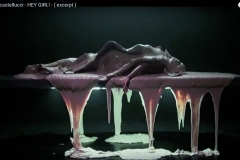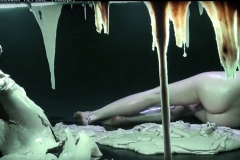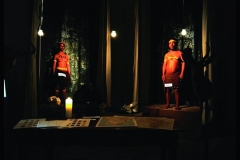When I see international festival curators at work – watching performances, taking notes, talking to colleagues or reflecting by themselves – I often think about categories that decide programme choices for festivals or theatres, which in turn influence the artists who see these selected works, perhaps in turn shaping their new work. And how all this develops into what could be called the aesthetic consensus of European performing arts.
For years contemporary programmes of theatres and theatre festivals have contained performing arts and performance art, visual arts, band concerts and cinema, all side by side. Strictly speaking, it is a bit silly to attach ‘theatre’ or ‘dance’ to the word ‘festival’, and perhaps because of this the previously named August Dance Festival is now simply the SAAL Biennale. Blending different art fields in performing arts no longer only happens in big cosmopolitan cities, but also in regional centres and venues in small towns across Europe. It increasingly seems that modern liberal Europe – the blending of art forms is an expression of this – is a set of islands located on European territory, and ‘province’ is an intellectual, not a geographical notion.
It is blending as an aesthetic common denominator that connects European ‘cool’ theatres in some sort of perceptible network. This network often formally exists – there are joint programmes and joint applications – although in most cases it can be perceived the moment you enter a theatre and something (maybe the font on the posters, something in the lighting or in the people in the foyer, artists from various fields in the programme) tells you that wherever you find yourself, you have come to something similar to HAU in Berlin or to Nanterre Armandiers in Paris. You are at home.
The blending, however, does not just happen in the theatre programmes, but also between artists. It often seems that an actor, a graphic designer and a metal artist can have much more in common than two theatre people who might even formally belong to the same creative union. Although this seems a recent phenomenon, it actually is not. As early as the explosive 1920s there were numerous creative associations that included various art fields; a good example is the circle of photographers, writers and designers surrounding the Russian journal ЛЕФ. It has been claimed that forcing creative unions to specialise in just one field (at least in Russia) was largely a method of the Stalinist era, aiming at more efficient control over the unions. Artists, however, might be united by totally different categories rather than a joint art field.
The blending of various fields can be purposefully encouraged by curators and festival organisers – either by aesthetic consensus or conditions of financing programmes – but such associations essentially emerge as explosions. Platforms can be created, but artistic blending is not automatically fascilitated by building the supportive infrastructure, and contacts cannot be pre-planned. Everything starts with human relations, an artistic chemistry between specific artists of different areas. And maybe even more crucially, with the broader social situation.
The blending of different art fields as a phenomenon in contemporary European theatre has its lineage. One (although by no means the only) initial source of this contemporary aesthetic consensus is the Flemish performing arts scene of the 1980s in Belgium: Anne Teresa De Keersmaeker, Wim Vandekeybus, Jan Lauwers, Jan Fabre and Alain Platel. Strictly speaking, they should be called choreographers and theatre directors, but the tectonic changes that happened in the Flemish scene in Belgium gave rise to the now widely accepted understanding that art is art is art is art, and it does not make much sense to rigidly differentiate between disciplines.
On the other hand, blending in the Flemish scene often happened within the work of a single artist. After all, the theatre director Jan Lauwers was initially a painter, like the broad-profile enfant terrible Jan Fabre, who already at twenty attached a sign to his parents’ house: “Here lives and works Jan Fabre”. These artists blended dance and theatre, visual arts and performance already in their early works.
The Flemish scene in the 1980s was also fascinating because of the way society influenced the birth of blending art fields as a phenomenon. In interviews and private chats, curators and artists have said that one of the main reasons why such an aesthetic restart occurred in the Flemish scene was that back then the Flemish theatre had no strong aesthetic tradition in the prevailingly French-speaking Belgium. “We didn’t have a father whom we had to kill, so we could do as we pleased,” said Alain Platel in an interview. Ground zero. Inventing the wheel at that time has had an immense impact on today’s European theatre aesthetics. In Estonia, too, blending in performing arts was not quite so legitimised a few decades ago as it is today. Theatre (although it could be said that this particular art form has always united disciplines, e.g in the person of the refined colourist Eldor Renter) back then was certainly running on the more secure rails of text-based theatre. The ideological and aesthetic roots of today’s Von Krahl Theatre, Kanuti Guild Hall, Theatre NO99, Tartu New Theatre, Cabaret Rhizome and Free Stage can be found approximately in the period of the birth of Ruto Killakund’s performances, Siim-Tanel Annus’s performances and the festival Baltoscandal. A significant impact on becoming legitimate was no doubt played by the surge of Estonian contemporary visual art in the 1990s and Mati Unt as an interdisciplinary artist with an international grasp who had a huge role in putting the cultural and aesthetic shifts taking place in Estonia into a global context. However, as with the Flemish scene, personal relations and mutual impact were quite important, which could all be mapped by comprehensive research.
Despite the triumph of blending in performing arts, there are still issues of reception and wider social communication. Although for the practitioners and theoreticians of performing arts, and for the more change-eager audiences, the interdisciplinary art projects often seem most exciting, they nevertheless exist in a social context where the taste of the more wider audiences may be much more conservative and experimentation-shy. European theatre as a whole will of course never become like Jan Lauwers’s works, and there is no need for it to be. All of that would not be a problem if reception were not linked with financing. In the conditions of economic difficulties, for example in the Netherlands, where the blending of arts had perhaps developed furthest in Europe, cuts mostly occurred in the field of experimental performing arts. Other examples of aesthetic conservatism being encouraged by political conjuncture are the latest developments in contemporary Russian theatre, where there is also talk of the danger of cuts in state funding.
“No, we do not rely on the income from tickets that much. Naturally we have a strict budget that we follow but if we mainly relied on selling tickets, we would not be able to do what we are doing. Sometimes the halls are full and sometimes they are not,” said the programme director for performing arts of the Berlin’s HAU recently in a conversation we had. This is a theatre where Rimini Protocol merges theatre and sociology and Ivo Dimchev brings together theatre and performance. “Theatre can only exist in the conditions of state funding. The entire contemporary European theatre proves it and the almost non-existent American contemporary theatre scene also proves it,” said Marina Davydova, the best Russian theatre critic and the theatre curator of next year’s Wiener Festwochen, in an interview. The blending of art fields in performing arts remains essentially a modernist project that sails against the winds of market rules.











